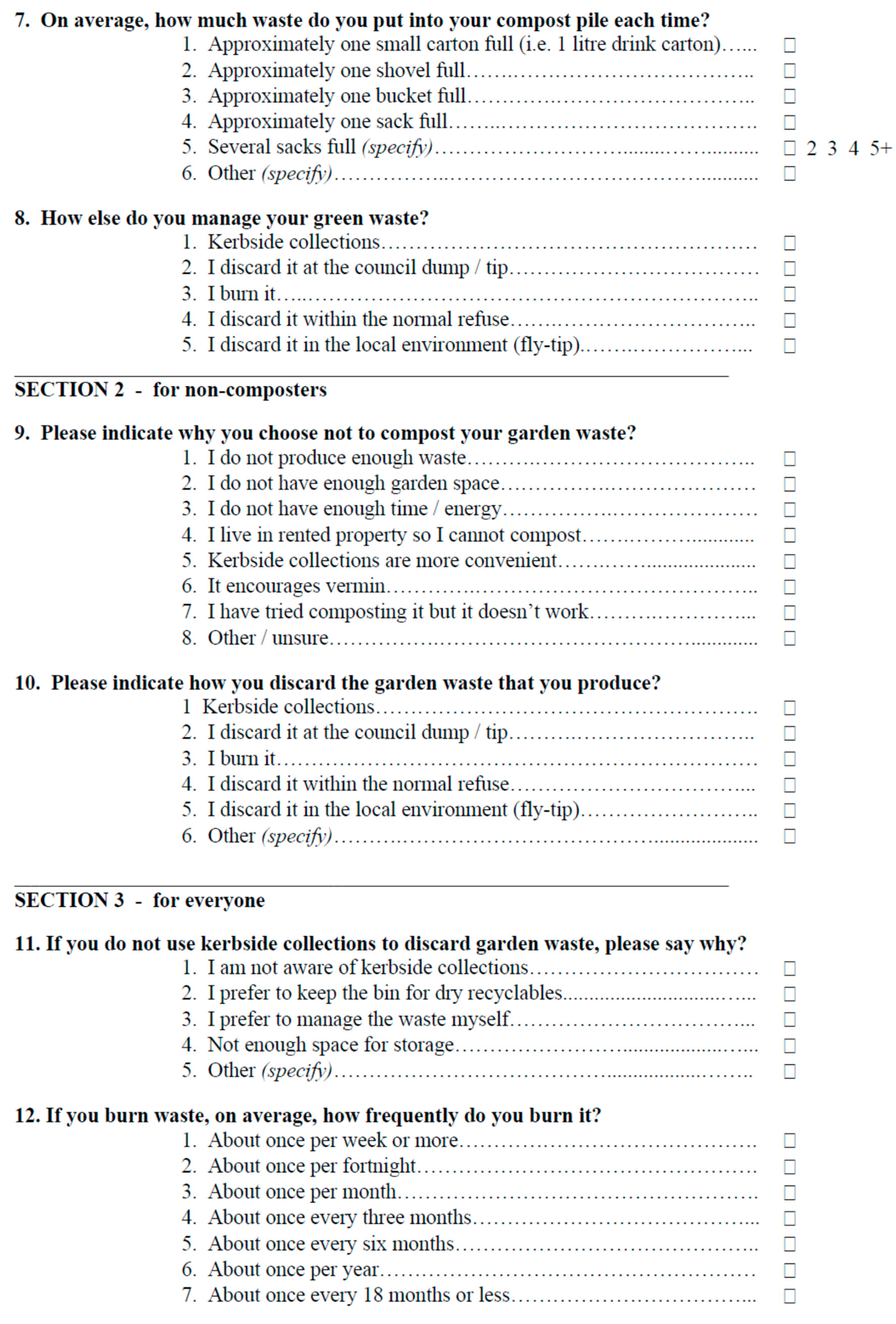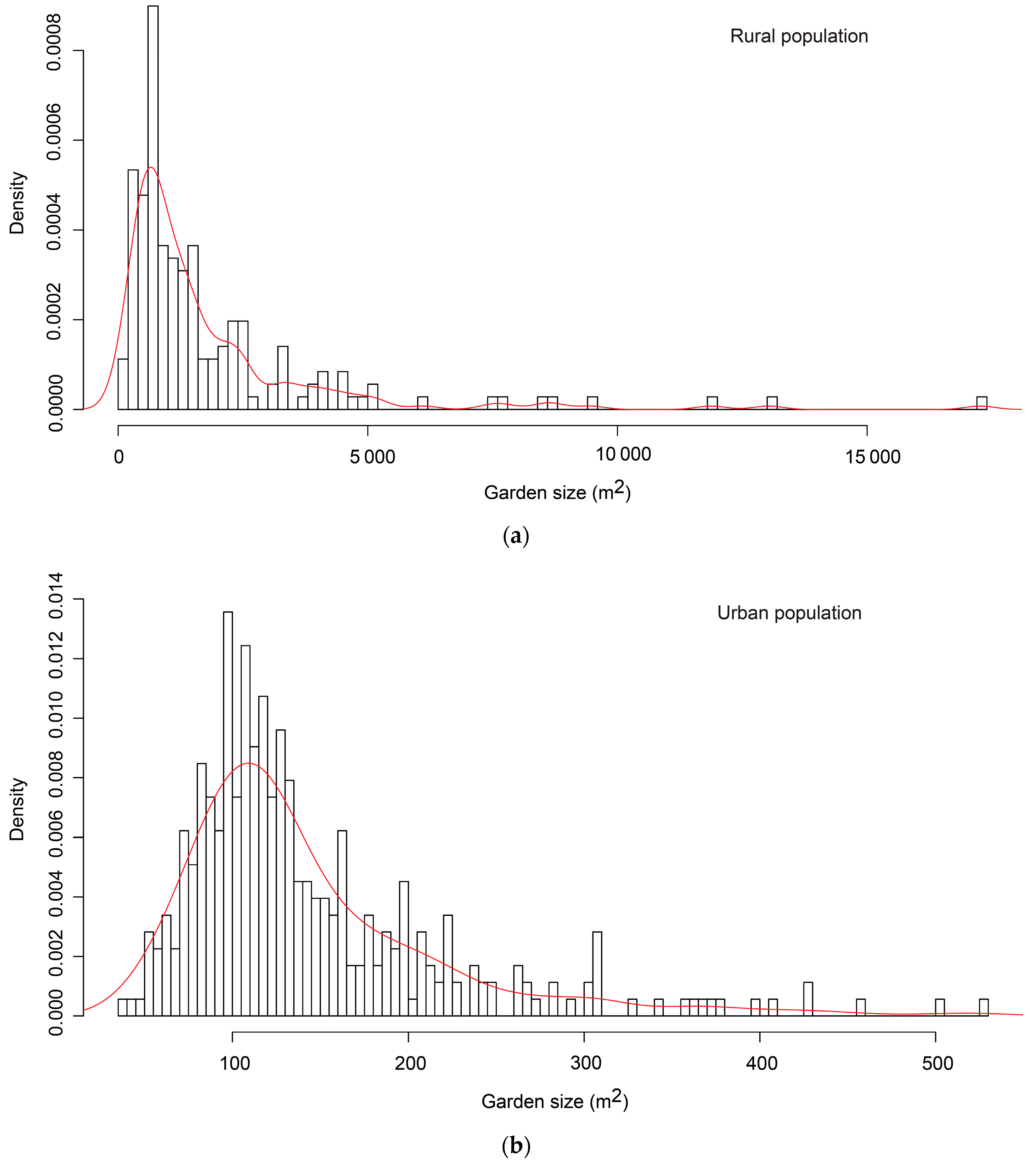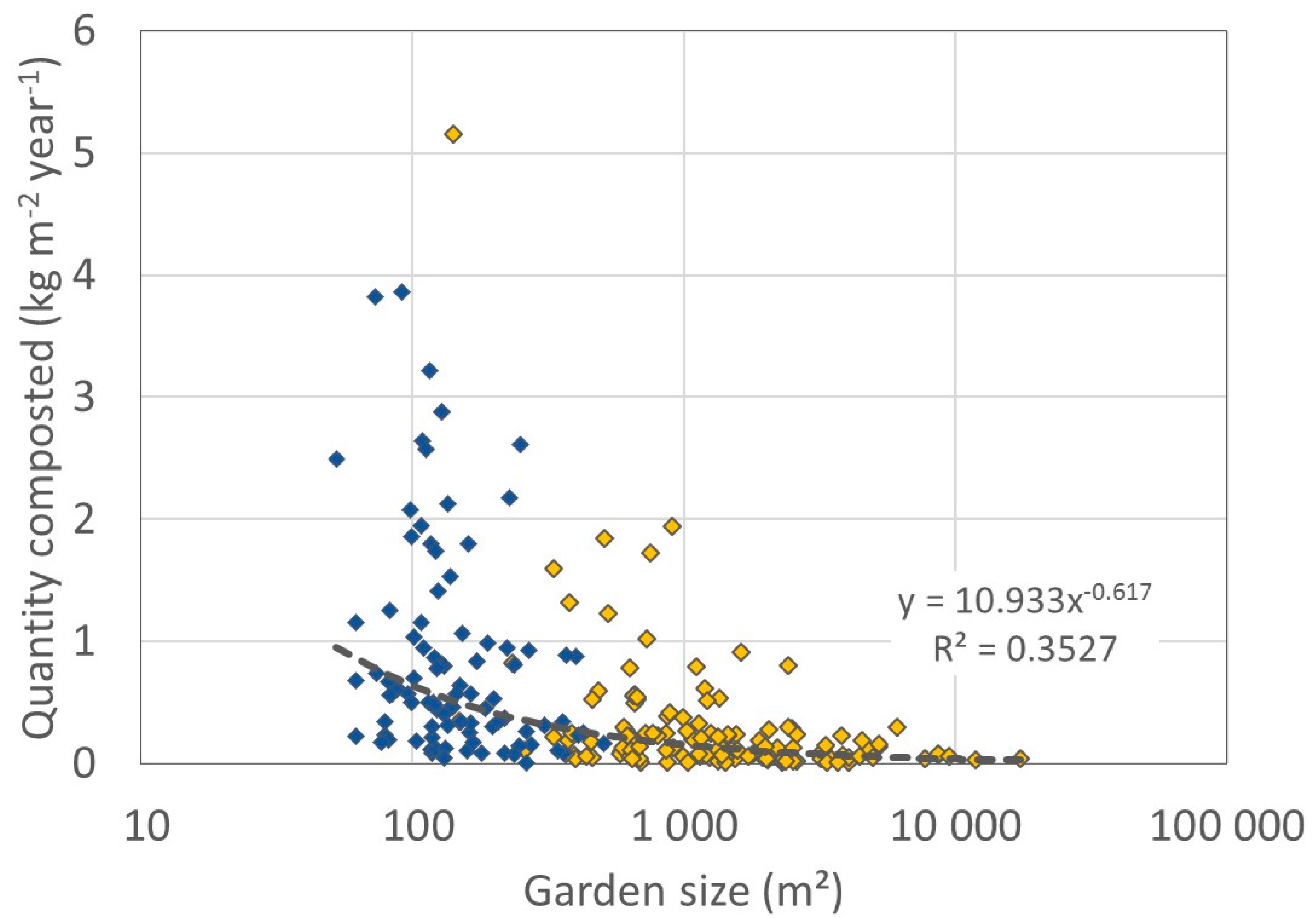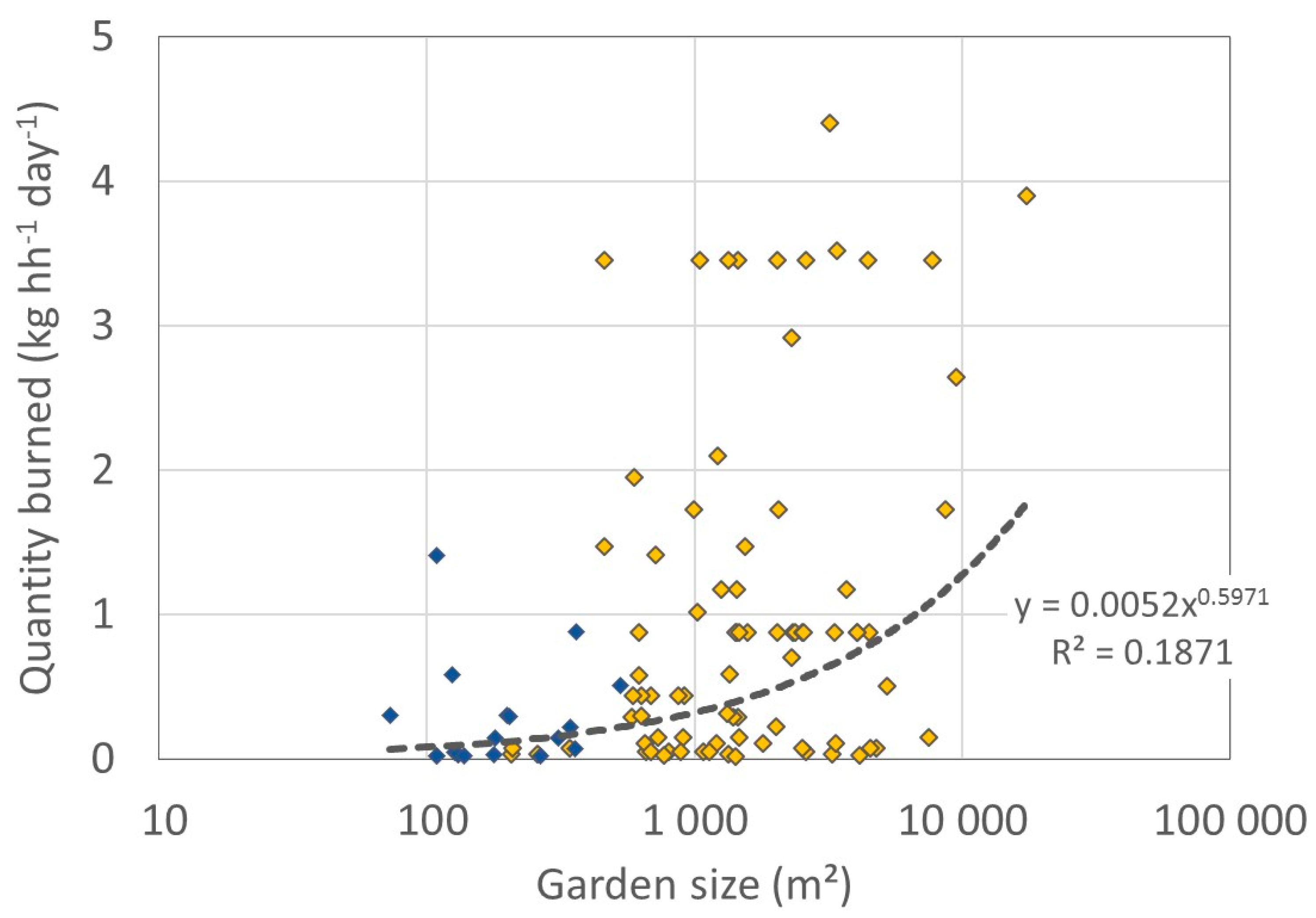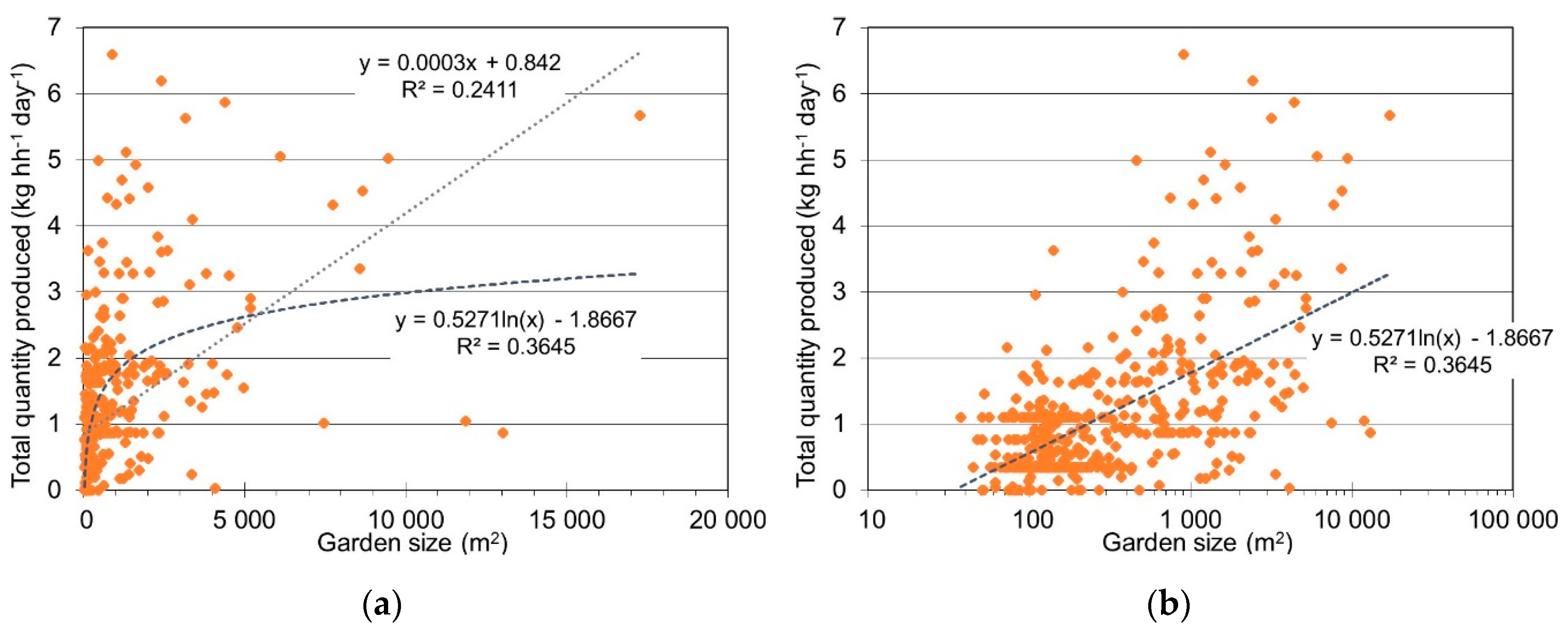3.1. What Rural and Urban Households Do with Their Garden Waste
Results of the door-to-door interviews provide evidence that most households use more than one garden waste disposal method, and that there are significant differences between urban and rural households. As shown in
Figure 1, kerbside collection was the most frequent choice in both the rural and urban area; this method was used by around 80% of households irrespective of their location (78.1% of rural households and 83.1% of urban households). Usage of HWRC facilities was slightly higher for the urban population; one third of the urban households and nearly one quarter of the rural households made use of this method. Composting and burning were far more common among the rural population. Overall, urban households largely relied on the services operated by the waste collection authority (kerbside collection and HWRC), while rural households used these services as well but also used methods of self-sufficiency to a significant extent.
It has also been reported in the literature that in the UK just over 1 in 3 households with access to a garden make use of home composting [
36]. The results of this study are in agreement with this figure: when considering that 18.5% of the private gardens in England are rural while 81.5% are urban (see
Section 2.5), the weighted average of the present data suggests that 35.6% of households in England with access to a private garden practice home composting. Among those households practicing home composting, 37% are rural, and 63% are urban.
These results show that especially for rural populations there is a significant difference between garden waste generated and garden waste entering the services operated by the waste collection authority.
Although all households surveyed received a free garden waste collection service, a small number of householders still used the residual waste bin on occasions (ca. 11% of urban households and ca. 4% of rural households indicated they occasionally put some garden waste into the residual waste bin) (data not shown). This is not unusual; while the extent to which this is practiced strongly depends on the waste management schemes offered by the authorities [
6], it is still common that some garden waste is found in the residual waste stream even where extensive separate waste collection schemes are in place [
2]. Around 1%–2% of the population also admitted to fly tipping garden waste into the local environment (illegal practice) despite the availability of free collection services and a nearby bring site. While there are known issues with the accuracy and reliability of self-reported waste management behaviours in surveys of this type [
37,
38], it is interesting that participants felt able to acknowledge this choice. This suggests a proportion of material is disposed of by these routes; however, actual quantities could not be determined in this work.
Out of the 178 interviewed rural households, two households (=1.1%) indicated no relevant garden waste generation and not making use of any of the four disposal routes included in
Figure 1, but both admitted to occasional fly tipping some garden waste into the local environment. Out of the 354 interviewed urban households, 16 (=4.5%) indicated no relevant generation of garden waste and not making use of any of the four disposal routes included in
Figure 1; of these, 14 indicated they occasionally put some green waste into the residual waste bin, one admitted to occasional fly tipping, and one indicated discarding some green waste on an allotment. These garden waste quantities were not quantified in this work; the two rural and 16 urban households which did not use any of the four disposal routes shown in
Figure 1 are methodologically included in the following analysis with zero garden waste arising.
3.2. Quantities of Garden Waste Subjected to Home Composting
The weight of garden waste home composted by those using this method was on average 0.86 kg hh
−1 day
−1 (standard deviation (SD): 0.99) and 0.32 kg hh
−1 day
−1 (SD: 0.32) for rural and urban locations respectively (
Table 2). The high standard deviations are again because the means are skewed by a small number of households with significantly higher quantities than most others (
Figure 2). In the present study, the medians for composted garden waste were 0.50 and 0.19 kg hh
−1 day
−1 for rural and urban households respectively, i.e., 50% of rural households using this practice composted at least 0.50 kg hh
−1 day
−1 and 50% of urban households using this practice composted at least 0.19 kg hh
−1 day
−1.
According to the data presented above in
Section 3.1, 71.9% of rural households made use of home composting, but only 27.4% of the urban households used this method. When non-composting households are included, the average for the surveyed rural and urban populations was reduced to 0.63 kg hh
−1 day
−1 (SD: 0.93; median: 0.26) and 0.09 kg hh
−1 day
−1 (SD: 0.22; median: 0 because <50% of urban households composted at all).
When looking at the distribution of quantities among the set of rural and urban households, shown in
Figure A3 (
Appendix B), it is evident that no distinct pattern of distribution was present. High variations of data at a household level are also reported elsewhere in literature [
6]. Interestingly, the level of experience was not found to be a significant factor to explain the different quantities of garden waste composted: Davey et al. [
39] confirmed that households new to home composting can achieve levels of performance comparable to experienced home composters within just few months.
By analysing waste management statistical data, Parfitt [
6] determined that those households which make use of home composting in the UK on average divert away 160 kg garden waste hh
−1 year
−1 from the collection schemes of the waste management authorities. This is lower than the results of this study: taking into account that in England 37% of the households practicing home composting are rural while 63% are urban (see
Section 3.1), the weighted average of the present data suggests that those households which practice home composting on average compost 0.52 kg hh
−1 day
−1, or 190 kg hh
−1 year
−1. Interestingly, Davey et al. [
39] after analysing data over several years identified that the amounts of garden waste home composted remained largely unaffected by changes in the garden waste collection schemes offered by the authorities, including the introduction of separate kerbside garden waste collection; they concluded that garden waste collections tend to complement rather than compete with home composting.
It has been reported that composters tend to be affluent, older, with large gardens and a higher interest in gardening [
36]. Parfitt [
40] identified that the garden size of experienced home composting households was on average 100 m
2 larger than other householders.
Figure 2 shows a scatter-plot of garden size against the quantity of garden waste home composted by individual households. Garden waste home composting tended to be more common with increasing garden size, which is in agreement with the literature, but there was wide variation in individual quantities composted. The coefficient of determination (R²) of the regression was low (<0.2). Therefore, according to these results, knowledge of the garden size does not allow making a reliable estimation of the quantities of garden waste subjected to home composting by private households. Possible reasons for this phenomenon are discussed in
Section 3.8.
Another interesting observation can however be made in
Figure 2: The variation of the data for composted quantities increased among the properties with larger garden sizes, and in particular among properties with garden sizes >1000 m² for the rural data set and >100 m² for the urban data set. This suggests that garden waste practices strongly differed especially among properties with larger garden surfaces. Thus, the variations among the properties with large garden surfaces are identified as a factor to explain the high standard deviations and the significant difference between mean and median values mentioned above.
Per unit of garden size (kg m
−2 year
−1), the composted quantities also showed significant variations (
Figure 3). As a tendency, it was observed that large properties composted less quantity per unit of garden surface available to them, but the coefficient of determination (R² = 0.35) is still quite low. On average, among the households using this disposal method, rural properties composted 0.30 kg m
−2 year
−1 (SD: 0.56; median: 0.12) and urban properties 0.85 kg m
−2 year
−1 (SD: 0.87; median: 0.56). In an experimental study using three model gardens and typical gardening practices in Portugal, Machado et al. [
20] obtained values for garden waste production of 0.95 kg m
−2 year
−1 (for a garden area of 379 m²) and 1.03 kg m
−2 year
−1 (garden area of 200 m
2). Home composting was the only garden waste disposal method considered in their study; but these results are reasonably close to the value for urban properties (mean garden size 144 m
2) obtained in this work. Machado et al. [
20] also noted that the quantity produced for composting per unit area of garden increased for a smaller garden size: the smallest garden of 45 m
2 produced 3.24 kg m
−2 year
−1, similar to the highest values obtained for small gardens in this study (
Figure 3). In a household-level analysis of UK home composting Davey et al. [
39] looked at the effect of garden size, but did not provide detailed data or results for compost production per unit area. The general lack of information on this topic and the support provided by these results for the findings of Machado et al. [
20] confirm the value of the data from the current study.
3.3. Burning of Garden Waste in the Backyards
A similar trend was observed in the quantity of garden waste burned by householders using this method (
Table 3,
Figure 4), with average values of 1.03 kg hh
−1 day
−1 (SD: 1.19) and 0.27 kg hh
−1 day
−1 (SD: 0.36) for rural and urban populations using this method respectively. Again, the high standard deviations show that the means are skewed due to some households with quantities significantly higher than the average. The medians were 0.59 and 0.15 kg hh
−1 day
−1 for rural and urban households using this method respectively, i.e., 50% of rural households using this practice burned at least 0.59 kg hh
−1 day
−1 and 50% of urban households using this practice burned at least 0.15 kg hh
−1 day
−1.
Only 6% of urban households burned some of their garden waste, but slightly more than 50% of rural households followed this practice (see
Section 3.1). When households which do not burn their garden waste are included in the analysis, the quantity disposed of by this route on average is 0.47 and 0.01 kg hh
−1 day
−1 for rural and urban households respectively.
Again, from
Figure 4 it can be concluded that there is no distinct correlation between garden size and the quantity of garden waste subjected to this treatment method. Therefore, no reliable prediction of the garden waste quantities diverted to backyard burning is possible based on the garden size. The variation is again particularly high among properties with large gardens. Backyard burning of garden waste is legal, however, it is worth pointing out that the quantities burned are significant in some households; here, significant potential for environmentally sound valorisation of organic waste remains untapped.
3.6. Aggregated Results: Garden Waste Arising of 715 kg per Year for Rural and 233 kg for Urban Households
The total quantity of garden waste produced was estimated by aggregating the information collected in the door-to-door interview survey, analysis of kerbside collections, and the HWRC analysis (quantities put in the residual waste bin or disposed of through fly tipping could not be quantified).
Table 6 shows the weight (kg) per household, disaggregated for the rural and urban population, and
Table 7 amends the statistical data. The average generation rates were 1.96 ± 1.35 kg hh
−1 day
−1 for rural and 0.64 ± 0.46 kg hh
−1 day
−1 for urban households respectively. This corresponds to an average annual arising of 715 ± 492 and 233 ± 167 kg per household at rural and urban properties.
It is interesting to note that, based on this method of estimation, 84% of the garden waste generated in the urban environment entered the services operated by the waste management authorities (kerbside collection, drop-off at recycling centre), but only 44% of the quantities generated in the rural area (
Table 6). More than half of all rural garden waste was subjected to self-sufficient methods (home composting and backyard burning). This result shows that especially in rural regions there exists a significant difference between garden waste generated and garden waste entering the official disposal routes.
Several factors might explain the more common use of home composting and backyard burning among rural households. The larger garden size (median of 1055 m² for rural compared to 121 m² for urban properties), with in consequence longer distances between properties means less risk of causing nuisance due to odour or burning fumes to the neighbours. Furthermore, it is likely that this is due in part to the greater volume of garden waste generated by rural households, combined with the limited capacity of wheeled bins and the frequency of the collection service. The average volume generated by rural households over a fortnightly period could total 130 L, based on an average generation rate of 1.96 kg hh
−1 day
−1 and a volume-to-weight conversion of 0.21 [
33]; but seasonal or week-to-week variations mean that the available 140 L wheeled bin will not always have sufficient capacity.
When the means of 1.96 kg hh−1 day−1 for rural and 0.64 kg hh−1 day−1 for urban households are weighted to represent Test Valley’s population distribution of 35.1% rural and 64.9% urban citizens, the overall average garden waste generation rate is 1.10 ± 0.88 kg hh−1 day−1. For Hampshire with a share of 21.8% rural population, the average garden waste generation rate can be estimated at 0.92 ± 0.75 kg hh−1 day−1. When considering only the quantities going to services operated by the waste management authorities, the average garden waste arisings would be 0.65 kg hh−1 day−1 in Test Valley and 0.60 kg hh−1 day−1 in Hampshire.
In the survey area, no properties on the chosen collection routes had no garden. Therefore, the values estimated for rural and urban areas refer to properties which have access to a private garden. These values are correct for the studied Test Valley area, and are probably reasonably representative for Hampshire; but care is needed in extrapolating the data to other parts of UK where garden provision may be less widespread, especially in different types of cities [
34]. Where local data for a specific city about the share of households which have a private garden are available, the data can be used accordingly. For England, an estimation is made in the following section.
3.7. Estimations for England: Average Annual Arising of 288 kg Garden Waste per Household (120 kg per Person)
In England, the population consists of an estimated 16.5% rural households with garden, 73% urban households with garden and 10.5% households without garden (mainly urban) (see
Section 2.5). Using the average garden waste generation rates of 1.96 ± 1.35 kg hh
−1 day
−1 for rural and 0.64 ± 0.46 kg hh
−1 day
−1 for urban households, the calculated average garden waste arising in England amounts to 0.79 ± 0.67 kg hh
−1 day
−1. This corresponds to an annual arising of 288 ± 244 kg garden waste per household. When considering only the quantities going to services operated by the waste management authorities, the average garden waste quantity can be estimated at 0.54 kg hh
−1 day
−1.
The garden waste generation rate of 0.79 kg hh
−1 day
−1 found in the current study for England is somewhat higher than the estimates of 0.68 kg hh
−1 day
−1 based on the studies by Parfitt [
25] and Defra [
26], which used a different methodology. The difference may be accounted for by the fact that the earlier studies did not take account of the burning of garden waste, while home composting estimates were based on the number of compost units distributed by a local authority. Based on the results of this study, the fraction of garden waste burned at home corresponds to 0.09 kg hh
−1 day
−1 or 12% of the total garden waste stream in England; this may be significant if changes in collection service provision or charges lead to changes in household practice. The methodologies developed in the current work are therefore potentially useful in providing a more detailed breakdown of the categories and routes chosen by householders to dispose of their garden waste.
Considering the average household size (2.4 persons) in England, the average garden waste generation of 0.79 kg hh
−1 day
−1 determined in this study corresponds to a per capita arising of 0.33 kg person
−1 day
−1, or 120 kg person
−1 year
−1. The estimated quantity of 0.54 kg hh
−1 day
−1 entering the collection schemes operated by the authorities corresponds to 0.23 kg person
−1 day
−1, or 84 kg person
−1 year
−1. For households in Denmark, Boldrin and Christensen [
21] determined a per capita garden waste quantity of around 110 kg person
−1 year
−1 at private households, but this included only those quantities which entered the official waste collection schemes operated by the authorities. The results of this study for England are comparable to the quantity determined for Denmark, but the results also highlight the need to consider those quantities which do not enter the official collection schemes.
3.8. Garden Size Is Not a Reliable Parameter to Predict Garden Waste Generation
For the households surveyed in this study, the generation of garden waste was also expressed as a function of garden area using data on quantities generated per household and the respective garden size (
Figure 5). As expected, there was in tendency a positive relationship between these parameters, but the degree of variability (low coefficient of determination) makes garden size unsuitable as a predictor for estimating the quantity of garden waste produced at a household or small-scale level. The variability was particularly high among properties with large gardens.
Per unit of land available to them, rural properties in the surveyed area generated on average 0.81 ± 0.99 kg m−2 year−1, while urban properties generated 1.89 ± 1.65 kg m−2 year−1 (the median values were 0.48 kg m−2 year−1 for rural and 1.32 kg m−2 year−1 for urban properties). These differences may be explained by the fact that in large gardens there are often areas that are less cultivated, or where residues such as grass cuttings or fallen leaves are left to decompose in place rather than being gathered. Conversely, urban householders with relatively small gardens tend to gather the majority of residues and dispose of them in order to maintain a tidy garden. It must be noted when making these comparisons, however, that the outdoor areas associated with each property are not always cultivated but may include drives, hard standing patio areas, decks, and other amenity features. In this research based on the use of digitised maps these could not be distinguished, but the methodology could be adapted to make use of the detailed aerial images which are increasingly available. While this might show the existence of a closer relationship to individual garden size than was found in the present work, it is likely that the variation in generation rates (shown by the high standard deviations) also simply reflects differences in practice by the individual householder.
Machado et al. [
20] also concluded that per unit of garden area available to them, smaller gardens generated significantly larger quantities of garden waste. For Portugal, they suggested an expected arising of 3 kg m
−2 year
−1 for gardens of <45 m
2, 1 kg m
−2 year
−1 for 45–200 m², 0.95 kg m
−2 year
−1 for 200–1000 m², and 0.6 kg m
−2 year
−1 for garden sizes of >1000 m². The values obtained in the current study (1.89 kg m
−2 year
−1 for urban properties with an average garden size of 144 m² and 0.81 kg m
−2 year
−1 for rural properties with on average 1836 m²) are slightly higher than those proposed by Machado et al. [
20]; however their research was based on a very small number of examples (three properties), all practicing the philosophy of sustainable gardening, and the authors note that under such practices the waste arising might be lower than for standard gardening practice. Machado et al. [
20] also highlight the lack of available data on garden waste arisings and the challenges of quantifying quantify this material stream; but argue in favour of estimating garden waste quantities based on the garden surface area, even though in their work the possible correlation was clearly shown not to be linear.
In contrast, Davey et al. [
39] used multiple regression methods to verify and extend household-level models for garden waste diversion, with data sets from up to 875 households. Variables considered included garden area in total and broken down into areas occupied by flowerbeds, lawn, vegetable patches, hedges/shrubs, built structures and hard standing, on the basis of visual observations. It was reported that the quantity of compostable garden waste presented for collection and the amount present in the residual waste bin both showed some positive correlation with the area of lawn and flowerbeds, and negative correlations with the area of hard standing. The results also indicated that, as expected, households with gardens of <200 m
2 diverted less than those with gardens >200 m
2; but no further analysis of production per unit area was reported, and the findings do not appear to offer clear support for the concept of using garden area as a predictor of the quantity of compostable garden waste.
The results of the current study, in particular the high standard deviations found (high data variability), strongly support the view that garden surface area alone does not represent a reliable parameter for prediction of garden waste arisings. More reliable estimations may be possible when gardening practices and the characteristics of properties and amenities are taken into account, although there will be a correspondingly sharp rise in the requirement for supporting data. Caution is due when interpreting data from a few households, as extrapolation from such findings carries a high risk of error. With 1139 surveyed households, the present study had a relatively large data set; nevertheless, the results reveal that more details are required to decide whether the hypothesis of a correlation between garden size and garden waste generation merits further attention under a more complex approach or has to be rejected as falsified.
3.9. Relevance of Findings and Recommendations
Based on analysing garden waste management practices at more than 1100 households, this work quantified garden waste arisings and elaborated a detailed breakdown of the quantities disposed of via the different waste management routes. The data contribute towards filling an important knowledge gap and can be used to support local authorities in the design of more effective waste valorisation strategies, along with more precise monitoring and calculation of waste indicators.
The results show that there is a considerable difference between the quantity of garden waste collected by waste management authorities and the total quantity of garden waste generated. This difference is particularly high in rural areas, where households frequently adopt self-sufficient methods of garden waste management. Home composting and backyard burning are both very common practices; among the surveyed rural households, 57% of garden waste managed by self-sufficient means was composted by the households while 43% was burned on the property. Home composting is considered a sustainable practice to valorise organic material at a local scale and at the same time decrease the waste quantities to be managed by the authorities [
41,
42]. Home composting has the potential to reduce the quantity of municipal organic waste in Europe by up to 50% [
42]. In the studied area, no separate charge was levied for any of the garden waste disposal services, and the households made their disposal choice without being incentivised through waste fee schemes. Self-sufficient waste management practices can be fostered by charging separate fees for services such as kerbside collection of garden waste. The results of this study suggest, however, that the effect of such a fee-based incentive might not necessarily be the more frequent adoption of home composting. Especially in rural areas, households are almost equally likely to adopt backyard burning practices. While this is legal, it is not a favoured choice under environmental sustainability and public health criteria [
43]. Home composting valorises garden waste into a useful soil conditioner, but this is not the case when burning the material. The generated smoke also creates air pollution and nuisance [
43]. Backyard burning requires no investment, however, while the capital cost for composting is an important reason for drop-out for some citizens [
44]. This suggests that waste management fees alone are not likely to be effective in encouraging sustainable forms of self-sufficient waste management practices.
Considerable differences were found between rural and urban households. Less than one third of urban households with a garden practiced home composting. This suggests that there exists a high potential to increase home composting by encouraging such practice among urban citizens.
By combining measurement campaigns with door-to-door interviews, the methodology applied in this study enabled a high level of detail and the consideration of materials that usually remain unquantified, such as garden waste burned in in the backyard. Despite the value of this data, it should be noted that the approach and the work done have some limitations. One shortcoming was that the kerbside collection data could not be disaggregated to the single household level, because the refuse collection vehicles were not fitted with on-board weighing equipment; these garden waste quantities were therefore calculated as mean values using the weighbridge tickets of each collection round. Future research or application of the developed methodology in practice should use refuse collection vehicles equipped with on-board weighing and should record the individual weight of each emptied bin. Furthermore, the study revealed that some households put garden waste into the residual waste bin or practice illegal fly tipping into the local environment despite the availability of services such as separate kerbside collection, but the scale of these practices could not be assessed quantitatively. Future research should explore this context with priority.

